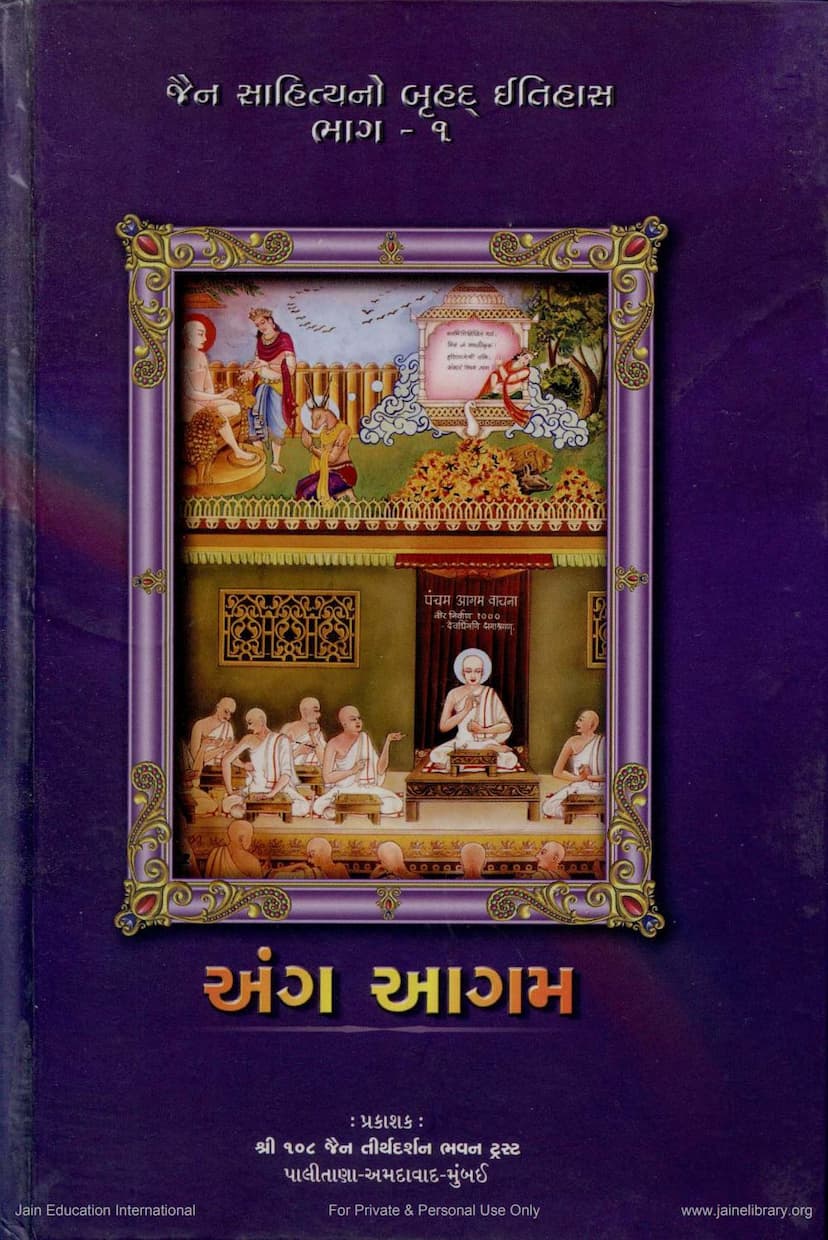Anga Agam Jain History Series 1
Added to library: September 1, 2025

Summary
Based on the provided pages of "Ang Aagam Jain History Series 1" by Bechardas Doshi, here's a comprehensive summary in English:
Book Title: Ang Aagam Jain History Series 1 Author: Bechardas Doshi Publisher: Shri 108 Jain Tirth Darshan Bhavan Trust
Overall Scope: This book is the first volume in a series dedicated to the history of Jain literature. It specifically focuses on the Ang Aagams, which are the foundational scriptures of Jainism, particularly within the Svetambara tradition. The series aims to provide a comprehensive historical overview of Jain literature, written by Pandurang Bechardas Doshi and translated into Gujarati by Dr. Ramanik Shah.
Key Themes and Content:
- Introduction to Jain Literature: The book begins by emphasizing the vastness and depth of Jain literature, comparing it to an inexhaustible ocean of nectar. It highlights the significant contributions of Jain Acharyas to various fields beyond just Agamas, including Nyaya (logic), Vyakarana (grammar), Sahitya (literature), Kosha (lexicography), Jyotisha (astronomy), and Vaidyaka (medicine).
2--- The Ang Aagams as the Core: The primary focus of this volume is on the Ang Aagams (also known as Dwadasangi or the Twelve Limbs of the Jain Canon). These are considered the direct teachings of Lord Mahavir, compiled by his Ganadharas (chief disciples). The text explains that the Ang Aagams contain the very words of Lord Mahavir and are the ultimate authority in Jainism.
Historical Context of the Ang Aagams:
- Compilation: The Ang Aagams were originally compiled by Lord Mahavir's Ganadharas immediately after his enlightenment.
- Oral Tradition: For centuries, the knowledge of the Ang Aagams was preserved through an oral tradition, with disciples meticulously memorizing and accurately transmitting the teachings generation after generation. This meticulous oral preservation highlights the importance placed on precise pronunciation and content.
- Scripturalization: The process of scripturalizing the Ang Aagams, i.e., writing them down, began around 1000 years after Mahavir Nirvana (approximately the 5th century CE), primarily in Valabhi. This shift from oral to written tradition led to a gradual decline in the reliance on pure memorization.
- The Angas: The book details the twelve Angas:
- Acharanga (Achar): Deals with conduct and discipline for monks, covering aspects like asceticism, purity, and ethical behavior.
- Sutrakrita (Sutrakrita): Discusses philosophical concepts, refutes non-Jain viewpoints (like Determinism and Ajivika philosophy), and elaborates on Jain doctrines.
- Sthana: Categorizes spiritual states and substances.
- Samavaya: Explains the classification and arrangement of various Jain principles.
- Vyakhyaprajnapti (Bhagavati): A very extensive Agama covering a wide range of topics, including cosmology, philosophy, and the teachings of various ascetics and philosophers.
- Jnatadharmakatha: Narrates stories and anecdotes to illustrate Jain principles and ethics.
- Upasakadasha: Details the conduct and vows of ten lay disciples (Upasakas).
- Antakritadasha: Describes the lives and liberation of great souls who have achieved emancipation.
- Anuttarauppapatikadasha: Discusses the lives of those born in the highest heavens (Anuttara Viman).
- Prashnavyakaraṇa: Deals with questions and answers related to various aspects of Jain philosophy and practice, including divination and astronomical predictions.
- Vipakaśruta: Explains the consequences (Vipaka) of actions (karma).
- Drishtivada: Considered the most comprehensive Anga, it is believed to be lost, containing extensive philosophical and doctrinal knowledge.
- Textual Variations and Preservation: The book touches upon the efforts made to preserve the scriptures, including the scripturalization process in Valabhi and the existence of different traditions or recensions (Vachanas). It also mentions the meticulous nature of the oral tradition and the importance of preserving the exact words and pronunciation.
-
Authorship and Tradition:
- The text emphasizes that the original teachings (Artha) were from Lord Mahavir, while the compilation into Sutras (Shabda) was done by the Ganadharas.
- It mentions the role of Acharyas and subsequent scholars in preserving, commenting on, and transmitting this vast body of literature.
- The book also acknowledges the challenges in precisely determining the dates of these ancient texts due to the nature of oral transmission and historical events.
-
Content of Individual Angas (Briefly): While the primary focus is on the Ang Aagams collectively, the introduction by the honorary editors (Dr. Nakin Shah and Dr. Ramanik Shah) provides a brief overview of the content of several volumes in the larger series, including the Ang Aagams. Volume 1, "Ang Aagam," is specifically detailed. It highlights the Angas' comprehensive nature, covering monastic conduct (Acharanga), refutation of other philosophies (Sutrakruta), classification of beings and substances (Sthana, Samavaya), detailed descriptions of various states and phenomena (Vyakhyaprajnapti), narratives illustrating Jain ethics (Jnatadharmakatha), lay disciple conduct (Upasakadasha), lives of liberated souls (Antakritadasha, Anuttarauppapatikadasha), philosophical discussions (Prashnavyakaraṇa), and the consequences of actions (Vipakaśruta). The lost Drishtivada is also mentioned as the most comprehensive Anga.
-
The Significance of the Publisher: The Shri 108 Jain Tirth Darshan Bhavan Trust, Palitana-Ahmedabad-Mumbai, is highlighted as the publisher. Their commitment to preserving and propagating Jain literature is evident through this series. The book also features the blessings of prominent Jain Acharyas, underscoring the spiritual lineage and support for this monumental work.
-
Core Jain Principles: Page 6 prominently displays a fundamental Jain principle: "Sarve Prana Sarve Bhuta Sarve Jiva Sarve Satta Na Hantavya..." (No living being, no creature, no soul, no entity should be killed, tormented, enslaved, harassed, or caused suffering). This is presented as the pure, eternal, and absolute Dharma taught by the omniscient Kevalis. This quote from Acharangasutra underscores the central Jain tenet of Ahimsa (non-violence).
In essence, "Ang Aagam Jain History Series 1" by Bechardas Doshi is an academic and historical exploration of the foundational scriptures of Jainism, the Ang Aagams. It delves into their compilation, content, tradition, and the scholarly efforts involved in their preservation and presentation.